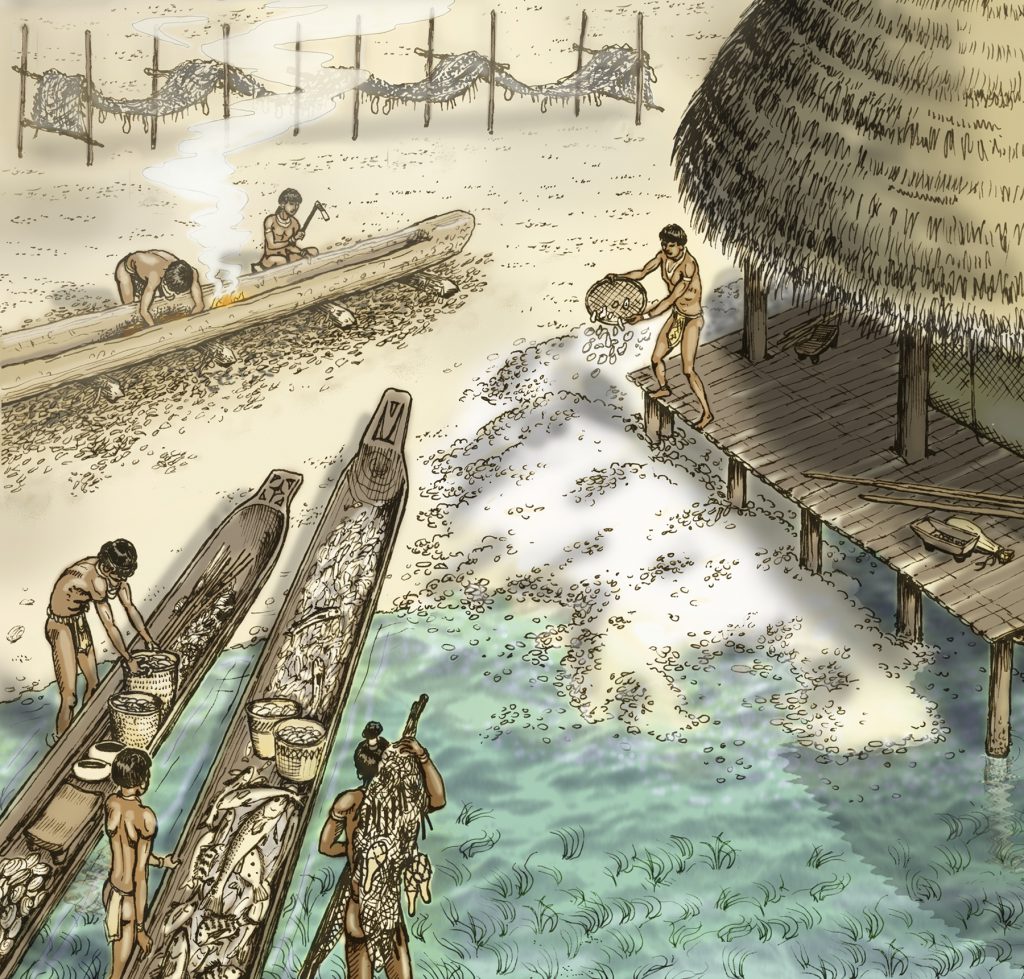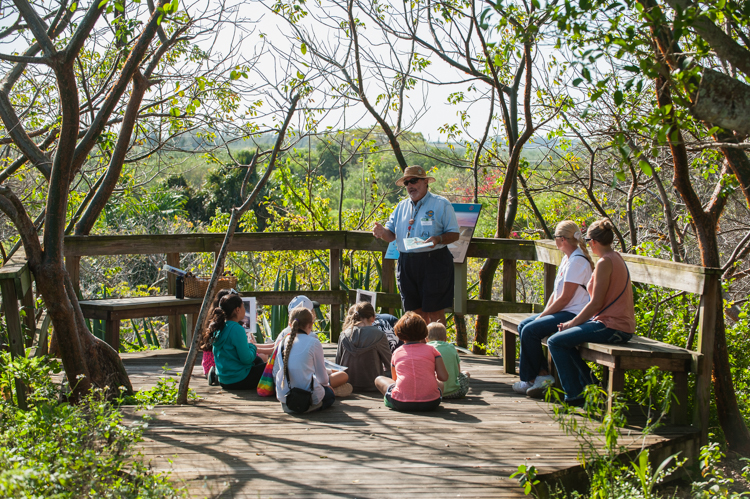Hurricane Ian struck Southwest Florida in the same place where Florida’s powerful Calusa natives lived over 2,000 years ago. From dealing with sea level fluctuations to a massive hurricane around A.D. 300, their fishing and building adaptations can teach us about dealing with coastal change.
Between the open Gulf of Mexico and the inland freshwaters, the estuarine shorelines of Southwest Florida buzzed with innovation. Atop the shell mounds, wooden housing structures brought their inhabitants closer to treetops than to the sea.
Who built all these structures? Florida’s Calusa Indians.
The Calusa people lived in the region 2,000 years before Hurricane Ian disrupted the lives of Southwest Floridians. They were a politically complex group of early Floridians with creative engineering skills honed through living and adapting to the risks of living on the coast.
Scientists say this powerful native tribe may have something to teach us about how to adapt during these stormy times and the climate changes ahead.
Up until the early 1990s, scientists assumed the environment of early Florida was homogeneous and bountiful. It was an Eden chock full of seafood, always easy to catch for these early Floridians. That’s why the Calusa were so successful, the scientists thought. But they were wrong.
Florida’s climate and environment had not been constant through time, says archeologist and Calusa scholar Bill Marquardt, curator emeritus of South Florida Archaeology and Ethnography at the Florida Museum of Natural History. The Calusa lived through several periods of rising and falling sea levels during their centuries on the coast. Given Southwest Florida’s shallow bays and estuaries, even subtle sea level changes were significant for the Calusa.
The Calusa first occupied Pineland on the northern end of Pine Island — about 30 miles north of today’s Fort Myers — by the first century AD. Then, they endured a massive hurricane around A.D. 300. Evidence shows seagrass and other debris floated to the tops of mounds, where archeologists wouldn’t expect to find them. Remains of saltwater creatures, including sea urchins and a seal, were also unexpectedly discovered.
Those finds reveal just how powerful the hurricane was, estimated to be a Category 3 or 4 based on today’s scale.
Marquardt infers that there were other storms during those times due to a period of warmer sea-surface temperatures — like today, the perfect recipe for stronger storms.
Then, a period of global cooling from about A.D. 500 to 840 lowered sea levels — a challenge for the Calusa due to the locations of their settlements along inshore bays. This change led to resource scarcity — shown by evidence of a decline in fish numbers and shell mounds below the water table. The Calusa settled along the water when sea levels were lower to have better access to the fish. When the levels were higher, they moved their houses inland in case of flooding.
The Calusa made major adaptations in Pineland amid these periods of tumult. During a warming period sometime after the first millennium, in about 1080, a higher sea level gave the Calusa more water than they knew what to do with. Not far from where Hurricane Ian wiped out Matlacha Pass Bridge, they expanded a major central canal and connected it to a two-and-a-half-mile-long transport canal that they dug across Pine Island.

They also began moving upland, building their houses — made of midden materials such as food scraps, shells, debris and dirt — perpendicular to the water along linear mounds. That allowed them to still live near the water — on the canal — but to also access the interior of the island. The sophisticated engineering fostered trade and communication, contributing to the tribe’s power and complexity.
The Calusa occupied Mound Key, along Estero Bay southeast of today’s Fort Myers Beach, beginning around AD 500. They mined old midden materials from throughout the bay to create the site. It became like their own artificial island. Soon they built houses on top, including a ceremonial center that housed the leader of the Calusa people. The structure signifies Mound Key was the capital of the Calusa. A canal there was also enlarged in the same century as the Pineland central canal.
“The Calusa took a very conscious engineering effort,” says Marquardt.
Anthropologists are fascinated by the Calusa because they became so advanced relying not on agriculture but on fish consumption, typically mullet and shellfish, in their fisher-gatherer-hunter society. Like modern-day fish farmers, they built water courts — and fish traps or short-term storage ponds that allowed a stable population of fish during times of decreased fisheries.
“It’s that resiliency that is key,” says Isabelle Holland-Lulewicz, an archaeology professor and director of the Socio-ecological Histories of Estuarine Landscapes Lab at the Pennsylvania State University.

The Calusa understood change is part of the environment — and societal mechanisms to deal with that change are crucial. “Everything that past people did, all their societies, their cultures were based on both human cultural things and environmental constraints,” says Nancy White, an archeologist and professor at the University of South Florida.
Water courts may have helped build political and social power. Their timing, around AD 1250 to 1400, indicates the environmental changes may have threatened other tribes’ respect of the Calusa leadership, who validated their power by being able to store large quantities of fish.
“This is another example of showing how past people — even without refrigerators, or video conferencing, or horses to pull carts — were so much more sophisticated than we realized,” says White.
The Native Americans began anticipating change, contributing to their back-and-forth settlement patterns. They knew that staying in place on the barrier islands was not sustainable. The canal systems brought more people into the area, so there were more mouths to feed. The leadership supported the changes, and the Calusa adapted.
“Today, there’s kind of a notion that climate change is a really bad thing,” says Marquardt. “That’s because we have a vested interest in the status quo. We don’t want change.”
We are facing the same fundamental issues today, except with 8 billion people on the planet. They need food, water, and other resources that can be derived from sources other than fossil fuels, says Marquart. There are people now anticipating change, with new technologies being developed to overcome the crisis of climate change. It will take support from leadership for widespread implementation.
Marquart describes his first time seeing the unique Southwest Florida environment as an emotional feeling. “Like wow, this is really, really different,” he thought.
Growing up in Tampa, he had not seen how the geology, fishes, and plants worked together to form the enchanting estuaries. He witnessed firsthand why the environment was important to the Calusa people.
He tells a story about the time he invited school kids to see the archeological work at the Pineland site. He got a shocking surprise after the kids got off the school bus.

“I’m talking about Lee County kids now. It’s a coastal county, where Fort Myers is. Kids got off the bus, and they were transfixed,” he says. They had never seen the estuarine waters before.
“They’re going to be voters, mostly, in this county,” Marquardt says. Yet, “they have no idea how the environment works.”
He concludes that the Native Americans were able to survive and prosper along the coast because they came understood and respected the environment. This is something that he came to value throughout his work studying the Calusa in Southwest Florida.
“I came to appreciate how the mangrove forest, and the mud flats and the sea grasses work together to provide ample amounts of fish and to protect the land from storm surges,” Marquardt says.
The values of Indigenous knowledge were long ignored in science and the mainstream media. Yet our indigenous forebears built knowledge from thousands of years on the Florida peninsula.
Their story could help encourage modern coastal-dwellers to become in touch with the land and adapt.
“You can’t divorce people from their environment,” Holland-Lulewicz says. However, “we have done it, surprisingly, in modern times.”
 Living on the Edge
Living on the Edge